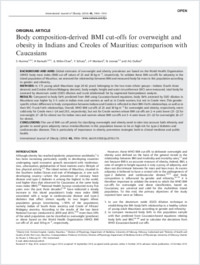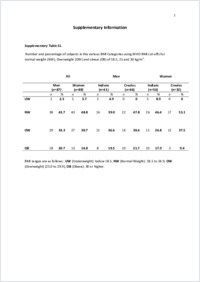Body composition-derived BMI cut-offs for overweight and obesity in Indians and Creoles of Mauritius: comparison with Caucasians
- Hunma, S Obesity Unit, Victoria Hospital, Candos, Mauritius - Division of Physiology, Department of Medicine, University of Fribourg, Switzerland - Ministry of Health and Quality of Life, Port Louis, Mauritius
- Ramuth, H Obesity Unit, Victoria Hospital, Candos, Mauritius - Division of Physiology, Department of Medicine, University of Fribourg, Switzerland - Ministry of Health and Quality of Life, Port Louis, Mauritius
- Miles-Chan, Jennifer L. Division of Physiology, Department of Medicine, University of Fribourg, Switzerland
- Schutz, Yves Division of Physiology, Department of Medicine, University of Fribourg, Switzerland
- Montani, Jean-Pierre Division of Physiology, Department of Medicine, University of Fribourg, Switzerland
- Joonas, N Obesity Unit, Victoria Hospital, Candos, Mauritius - Ministry of Health and Quality of Life, Port Louis, Mauritius
- Dulloo, Abdul G. Division of Physiology, Department of Medicine, University of Fribourg, Switzerland
-
2016
Published in:
- International Journal of Obesity. - 2016, vol. 40, no. 12, p. 1906–1914
English
Global estimates of overweight and obesity prevalence are based on the World Health Organisation (WHO) body mass index (BMI) cut-off values of 25 and 30 kg m⁻², respectively. To validate these BMI cut-offs for adiposity in the island population of Mauritius, we assessed the relationship between BMI and measured body fat mass in this population according to gender and ethnicity.Methods: In 175 young adult Mauritians (age 20-42 years) belonging to the two main ethnic groups—Indians (South Asian descent) and Creoles (African/Malagasy descent), body weight, height and waist circumference (WC) were measured, total body fat assessed by deuterium oxide (D2O) dilution and trunk (abdominal) fat by segmental bioimpedance analysis.Results: Compared to body fat% predicted from BMI using Caucasian-based equations, body fat% assessed by D2O dilution in Mauritians was higher by 3–5 units in Indian men and women as well as in Creole women, but not in Creole men. This gender-specific ethnic difference in body composition between Indians and Creoles is reflected in their BMI–Fat% relationships, as well as in their WC–Trunk Fat% relationships. Overall, WHO BMI cut-offs of 25 and 30 kg m⁻² for overweight and obesity, respectively, seem valid only for Creole men (~24 and 29.5, respectively), but not for Creole women whose BMI cut-offs are 2–4 units lower (21–22 for overweight; 27–28 for obese) nor for Indian men and women whose BMI cut-offs are 3–4 units lower (21–22 for overweight; 26–27 for obese).
Conclusions: The use of BMI cut-off points for classifying overweight and obesity need to take into account both ethnicity and gender to avoid gross adiposity status misclassification in this population known to be at high risk for type-2 diabetes and cardiovascular diseases. This is particularly of importance in obesity prevention strategies both in clinical medicine and public health.
- Faculty
- Faculté des sciences et de médecine
- Department
- Département de Médecine
- Language
-
- English
- Classification
- Biological sciences
- License
- License undefined
- Identifiers
-
- RERO DOC 278630
- DOI 10.1038/ijo.2016.176
- Persistent URL
- https://folia.unifr.ch/unifr/documents/305417

